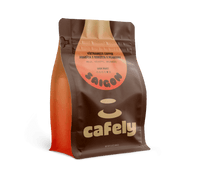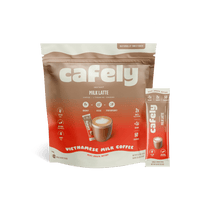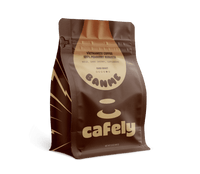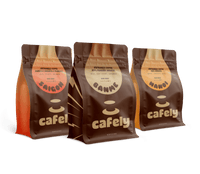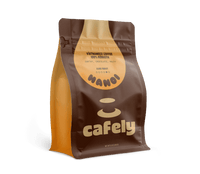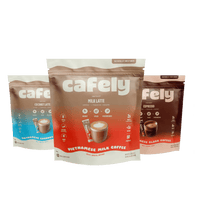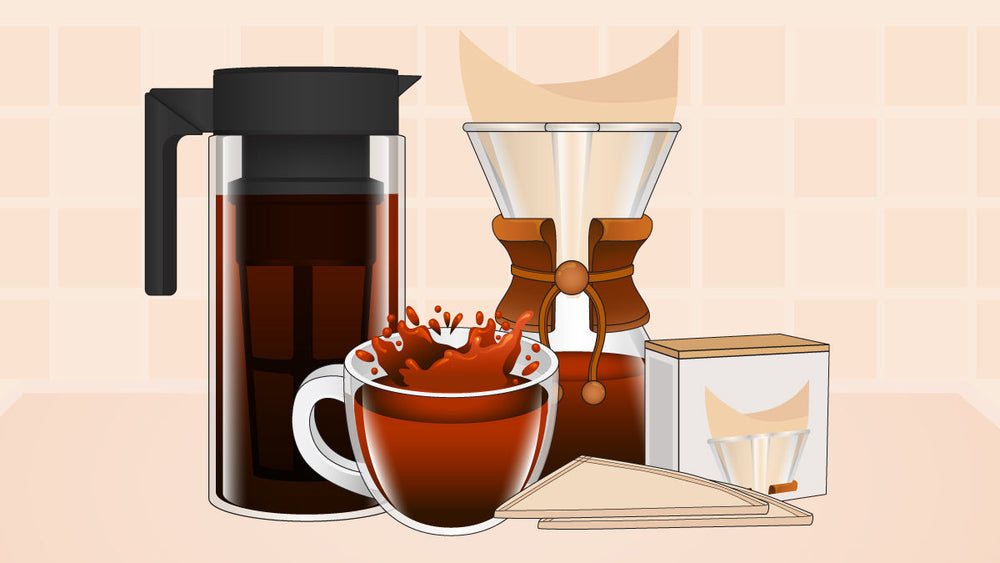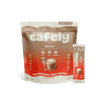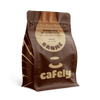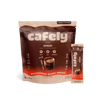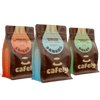Filter coffee is a staple in homes, cafés, diners, and offices across the globe — prized for its clarity, balance, and convenience.
While brewing methods can differ slightly, the attraction to the best filter coffee lies in its simplicity — pouring hot water over ground coffee to collect a filtered, smooth, flavorful brew below.
In this guide, we explore what sets filter coffee apart in terms of taste and texture, the origins of the brew, and how it’s made…
What is Filter Coffee?

Filter coffee is made via brewing methods that involve pouring hot water over ground coffee. The brew then passes through a filter — typically made of paper — to separate the liquid from the grounds.
Filter coffee is made using pour-over brewers or drip coffee makers. Hot water is manually poured over the grounds when pour-over brewers such as the Hario V60, Chemex brewer, and Kalita Wave are used. Hot water is automatically heated and poured over the grounds when drip coffee makers are used.
Unlike immersion methods of brewing, like the French press, the grounds of filter coffee aren’t steeped for as long.
Instead, the water flows through the grounds slowly, extracting the coffee’s soluble compounds steadily. The result is a cleaner, smoother, and more nuanced cup of coffee with a much less silty mouthfeel.
Flavor and Body of Filter Coffee
Filter coffee is known for its clean, refined taste. Since the paper or cloth filter removes most of the fine grounds, the brew tends to have a lighter body and a brighter flavor compared to pressure extraction (espresso and moka pot) and immersion (French press and coffee percolator).
You’ll often notice more distinct flavor notes when consuming well-made filter coffee. Floral, fruity, and nutty undertones can be picked up, especially when specialty pour-over brewers are used.
This is because the clarity of the brew and the faster extraction process (generally) leave behind the bitter, darker flavors of the beans.
With all that said, the taste of filter coffee can vary widely depending on what type of bean and roast is used. Arabica, robusta, and blends of both beans all create vastly different brews. Light, medium, and dark roasts also differ widely in flavor and aroma.
Here’s what to expect from a cup of filter coffee:
- Body — Light to medium.
- Moderate to High — This can vary depending on the bean and roast level used.
- Mouthfeel — Smooth, crisp, clean, and not silty (due to the finer filters used).
Caffeine Content of Filter Coffee
Despite the lighter body of filter coffee, it may contain more caffeine per serving than espressos, lattes, cappuccinos, and other coffee house favorites. This is due to the serving size and style — drip and pour-over coffee is typically served black or lightly creamed in large mugs.
The caffeine content of a cup of filter coffee can vary depending on the exact brewing method and the type of beans used. However, a typical eight-ounce (240 mL) cup of filter coffee contains 95 to 165 milligrams of caffeine.
Compared to the 60 to 80 milligrams in a shot of espresso, filter coffee is quite strong.
The Origins of Filter Coffee
Filter coffee has been around for hundreds of years in one form or another. From rudimentary cloth filters to the precise pour-over and electric drip brewing methods we use today, filter coffee has evolved over the centuries.
In this section, we look at the origins and key milestones that shaped how we brew and enjoy filter coffee today.
1700s–1800s: The First Accounts of Filter Coffee
The idea of separating coffee grounds from the water to create a cleaner brew didn’t come about until the mid to late 18th century in Europe. The earliest forms of filtered coffee were made using cloth filters made from flannel, muslin, or linen. Before this, the beans were typically ground finely and boiled using methods like traditional Turkish or cowboy coffee.
The “filters” used in France, Germany, and the Netherlands were different from the cone filters we use today. These cloth filters were often called “coffee socks” — they were more like a tea bag than a modern coffee filter.
These coffee socks allowed you to steep the coffee in hot water to extract its soluble compounds, without placing the grounds directly in the hot water. The brews were likely over-extracted and quite silty, due to the lack of fine filtration that the fabrics of the time offered.
In other parts of the world — especially Southeast Asia — similar cloth filter methods were used. Some of these traditional methods are still used today in places like Thailand to make Gafae Yen (Thai iced coffee).
1908: The Invention of the Paper Coffee Filter
One of the most revolutionary moments in the history of filter coffee came in 1908, when Melitta Bentz — a German inventor from Dresden — sought a way to make coffee that wasn’t bitter or over-extracted.
Bentz experimented using blotting paper from her son’s school workbooks and a brass pot she had punctured holes in.
She cut the blotting paper into circles, so they would fit perfectly in the bottom of the pot. The pot sat above a container, and ground coffee would be placed on top of the rudimentary filter. When hot water was poured into the brass pot, it would pass through the grounds and filter, leaving a clean brew in the container below.
Through her ingenuity, Melitta Bentz had created the first flat coffee filter. The paper filter allowed coffee drinkers to brew a cleaner, less oily cup of coffee with no lingering grounds in the final brew. This set the foundation for both manual and automatic drip filter systems in the future.
Bentz patented her invention in 1908 and founded the Melitta company, which still produces filters and brewing equipment to this day.
1936: The Paper Cone Filter is Invented
While Melitta’s original flat coffee filter worked, it didn’t produce an optimal extraction. The brew took a long time to pass through the filter, often leading to an over-extracted, bitter cup.
In 1936, the Melitta company invented the “conical filter cone” — the first paper cone filter, similar to what we use today. The cone filter improved water flow and made it easier to control the brewing process, resulting in faster extraction and a better quality cup of Joe.
This design eventually influenced modern pour-over brewers like the Chemex, Hario V60, and Kalita Wave…
1941: The First Mainstream Pour-Over Brewer Hits the Market

While Melitta’s invention of the paper cone filter laid the basis for drip and pour-over brewing, the hardware for efficient filter brewing took some time to catch up.
The first widely recognized, mainstream pour-over brewer hit the market in 1941 with the creation of the Chemex brewer.
The Chemex coffee brewer was invented by Dr. Peter Schlumbohm — a German chemist living in New York City.
It was made from borosilicate glass (a heat-proof material) and was shaped like an hourglass. This allowed a paper filter to be placed in the top with the ground coffee, and the brew to be collected in the chamber below.
The Chemex quickly gained popularity across Europe and the United States for its aesthetic appeal and functionality. It was this brewer that popularized pour-over coffee brewing, and it’s still loved by coffee connoisseurs today.
1954: The Invention of the Electric Drip Coffee Maker
In 1954, another German inventor by the name of Gottlob Widmann invented the “Wigomat” — the world’s first electric drip coffee maker. It used the same principles as the manual pour-over brewers of the time, but added the automation of electric heating and pouring.
The Wigomat set the stage for modern automatic drip brewers. It used universal Melitta cone filters and was widely available across Europe and the US.
It became a household appliance in homes across North America and Western Europe. However, the machine was unrefined compared to modern drip coffee makers. Over-extraction, clogging, and malfunctions were common.
1970s–1980s: The Rise of the Drip Coffee Machine
In the early 70s, the “Mr. Coffee Machine” was introduced to the American market. This drip coffee maker was much more reliable than the Wigomat and the automatic coffee machines of the past.
It was quickly adopted by millions of households in the United States, and by the 1980s, it became the standard brewing method in American homes, offices, and diners.
This era marked the mainstream adoption of filter coffee and the gradual decline of percolator coffee — a popular brewing method of the time.
1990s–2000s: The Revival of Pour-Over Brewing
From the 80s onwards, automatic drip coffee makers ruled — most households had one. However, the 1990s and early 2000s experienced a steep rise in the interest in specialty coffee.
Coffee drinkers began to prioritize quality, origin, and precision over convenience — this led to a renewed interest in manual brewing methods. The Chemex pour-over brewer was one of the first manual brewers to regain popularity, largely due to its elegant design.
Hario — a Japanese company — also introduced the V60 brewer. This precision pour-over quickly became a favorite amongst specialty cafés and home brewers for its spiral ridges and large drainage hole — ideal for controlling extraction.
The Kalita Wave, Origami Dripper, Clever Dripper, and other precision pour-over devices quickly followed, adding more variation to this manual filter brewing technique.
This period emphasized quality and experimentation. The interest of convenience shifted to craftsmanship, taste, and quality — turning brewing into an artisan skill.
2000s–Today: The Continual Evolution of Filter Brewing
In the 21st century, filter coffee continues to evolve.
Automatic drip coffee makers continue to improve, with innovations such as smart coffee machines that can be controlled through large display panels and even mobile applications. Manual pour-over brewers have become more refined, and eco-friendly filters (biodegradable and reusable) have gained popularity.
The interest in brewing techniques and coffee from across the globe has also grown. Vietnamese, Cuban, and Italian brewing methods are now a common practice in coffee shops and households across the US and Western Europe.
Read more about the history of coffee: Where Did Coffee Originate?
How to Make Filter Coffee (Pour-Over Brewer)

Pour-over is the manual brewing method used to make filter coffee. While several different brands, styles, and sizes exist, most pour-over brewers follow the same principle — manually pouring hot water over ground coffee to extract a filtered brew.
If you want maximum control over the extraction process, pour-over brewing is the way to go. Most connoisseurs agree that pour-over brewers produce a more complex cup of coffee than automatic drip brewers.
With that said, here’s a rundown of the brewing process:
What You Need:
- Pour-Over Brewer — These come in a range of shapes and sizes. The Hario V60, Chemex, and Kalita Wave are the most popular precision brewers.
- Coffee Filters — You’ll need paper or cloth filters. Opt for unbleached.
- Burr Grinder — A Medium grind is required for more pour-over setups. A burr grinder produces the most consistent grind.
- Coffee Measure — A coffee measure or scale is essential if you want to make great-tasting coffee consistently.
- Kettle — A gooseneck kettle provides the most control over water flow, but a standard electric or stovetop kettle works too.
- Coffee Mug — Use your favorite coffee mug for serving.
- High-Quality Coffee — Opt for a high-quality whole-bean coffee. We recommend 100% arabica or a well-balanced blend.
- Water — Use fresh, filtered water for making filter coffee.
- Milk (optional) — Add a splash of milk or coffee creamer to enhance the flavor and body of your cup.
- Sugar or Syrup (optional) — Sugar or syrup can be added to sweeten your brew.
Step-by-Step Guide
- Boil the Water — First, boil a kettle of fresh, filtered water and let it cool down slightly (30–60 seconds).
- Prepare the Pour-Over — Assemble your pour-over brewer. This will be different depending on the device you’re using. Place a filter in the chamber and saturate it in hot water. Wait for the water to pass into the collection chamber below, and discard. This preheats the equipment and removes impurities from the filter.
- Measure and Grind the Coffee — Measure and grind your coffee. Most pour-over setups require a medium grind, similar in texture to table salt. The amount you need varies depending on the brewer and the volume of coffee you wish to brew.
- Bloom the Coffee — Place your ground coffee in the filter chamber and spread it evenly. Pour a small amount of hot water to saturate the grounds. Wait for 30–60 seconds for the gases to release — this “blooms” the coffee for a more even extraction.
- Brew the Coffee — Once the coffee has bloomed, slowly pour the rest of your water over the grounds, moving in a circular motion. Wait for the brew to completely pass through the filter into the collection chamber below — the amount of time this will take varies depending on the brewer used.
- Pour, Adjust, and Enjoy — Remove the filter chamber from the collection chamber and gently pour a serving into your favorite coffee cup. Adjust the sweetness with sugar or syrup and cream with milk or creamer if desired. Enjoy your freshly-brewed coffee.
How to Make Filter Coffee (Drip Coffee Maker)
Making filter coffee with a drip coffee machine is the easiest and most convenient method. Drip coffee makers are automatic — they heat the water and pour it over the coffee automatically.
While you don’t have as much control over flow rates and water temperature, they do produce a consistently good pot of coffee.
Here’s how to make filter coffee with a drip coffee maker:
What You Need:
- Drip Coffee Maker — These machines come in a range of shapes, sizes, and costs. They all work in a similar way, but some are more efficient than others. Opt for a machine with a glass carafe — plastic or metal pots may taint the taste of your brew.
- Coffee Filters — Most drip coffee makers use standard paper filters. Opt for unbleached.
- Burr Grinder — A burr grinder creates the most consistent grind. This is the best option for turning whole beans into the medium grind required for this method.
- Coffee Measure — Use a coffee scoop or weighing scale to portion your coffee consistently.
- Coffee Mug — Serve your brew in your favorite coffee mug.
- High-Quality Coffee — Opt for a high-quality whole-bean arabica such as DaLat or a well-balanced blend such as Saigon OG.
- Water — Use fresh, filtered water for the cleanest brew. Don’t use tap water — this can lead to mineral buildup in your machine.
- Milk (optional) — Add a splash of milk or coffee creamer to your cup if desired.
- Sugar or Syrup (optional) — Sweeten your filter coffee with sugar, syrup, or a sugar-free sweetener if desired.
Step-by-Step Guide
- Prepare the Drip Coffee Maker — Make sure your brewer is free from spent grounds and residues. Fill the reservoir of your machine with cold, fresh, filtered water. Pre-rinse a paper coffee filter and place it in the filter basket, and put a clean carafe on the drip tray below.
- Measure and Grind the Coffee — Measure around 28 g (4 tbsp) of high-quality coffee and grind it to a medium consistency using a burr grinder.
- Brew the Coffee — Place the grounds in the filter basket, close the lid, and switch on the machine. Your coffee will now begin brewing. The amount of time it takes to finish the brewing cycle varies by machine and the volume of coffee you’re making.
- Serve, Adjust, and Enjoy — Once brewed, pour a serving of coffee into your favorite coffee mug. Adjust to taste using sugar, syrup, milk, and/or creamer if using, and enjoy your freshly brewed filter coffee.
How Does Filter Coffee Differ From Other Brews?
Filter coffee is praised for its clarity and balance, but how does it compare with other popular brewing methods? Each brewing method brings out different qualities in coffee — from intense, dark, bold espresso to mellow, smooth, low-acidity cold brews.
Here’s how filter coffee compares with some other popular brewing styles:

FAQs: What Is Filtered Coffee?
Want to learn more about filtered coffee and similar brews?
Check out the answers to the 10 FAQs below:
1. Is Drip Coffee the Same as Pour-Over Coffee?
Not quite. Both are types of filtered coffee, but drip coffee is made with an automatic coffee machine, while pour-over is made manually by hand-pouring hot water over the coffee grounds. Pour-over brewing provides more control over water flow and extraction rates, while drip brewing provides more consistent results.
2. Does French Press Coffee Taste Similar to Filtered Coffee?
It tastes similar. However, the French press uses submersion for extraction and a mesh plunger, which results in a fuller-bodied cup with a thicker, slightly silty mouthfeel. Filtered coffee is lighter and cleaner due to the use of a paper or fine cloth filter.
3. What's the Best Coffee for Making Filter Brews?
The best coffee for making filtered coffee should be high-quality and freshly ground. Opt for whole-bean coffee with a recent roast date. 100% arabica is a popular choice for its smooth, rich, naturally sweet flavor. However, well-balanced blends of robusta and arabica, such as Saigon OG, also work well.
4. What's the Best Grind Size for Making Filtered Coffee?
A medium grind size — similar in texture to table salt — is required for filtered coffee. This grind ensures that the water flows at a consistent rate through the grounds, producing an evenly extracted cup of coffee.
5. Can You Make Filter Coffee Without Paper Filters?
Yes. Reusable metal mesh filters and cloth filters are available for use in drip coffee makers. They may not produce as clean a brew, but they are more environmentally friendly and may save you money in the long run.
6. Can I Make Pour-Over Coffee With Robusta?
Yes. You can make pour-over coffee with robusta beans. Expect a stronger, more bitter brew with around twice the amount of caffeine as arabica. You may wish to sweeten and cream the brew with condensed milk, syrup, or coffee creamer to counteract the dark, bitter taste of robusta.
7. What's the Difference Between Arabica and Robusta?
Arabica and robusta are two different species of coffee. Arabica is smoother, sweeter, and less caffeinated, while robusta is darker, stronger, and more bitter, with around twice the amount of caffeine per gram compared to arabica.
8. How Should I Clean My Filter Coffee Maker?
After each use of your drip coffee maker, remove the spent grounds and filter. Then, rinse the removable parts and wash the carafe. Empty the water reservoir and rinse. Once per week — or month, depending on your frequency of use — run a mixture of vinegar and water through the machine to remove stubborn grounds, oils, and mineral residuals.
9. What is a Hario V60?
The Hario V60 is a popular Japanese pour-over coffee brewer known for its spiral ridges and large 60-degree cone shape. It provides precise control over water flow, brewing a clean, flavorful, perfectly extracted cup of coffee.
10. Does the Clever Dripper Make Filter Coffee?
The Clever Dripper combines the ease and powerful extraction of immersion brewing with the clarity of filter coffee. You can expect a strong, rich “French press-style” cup with a cleaner, lighter body.
